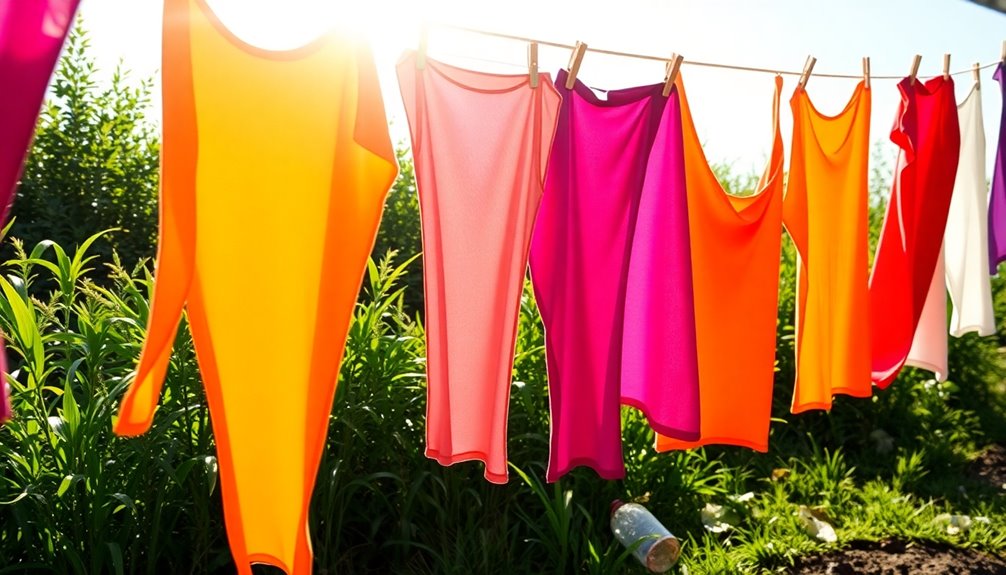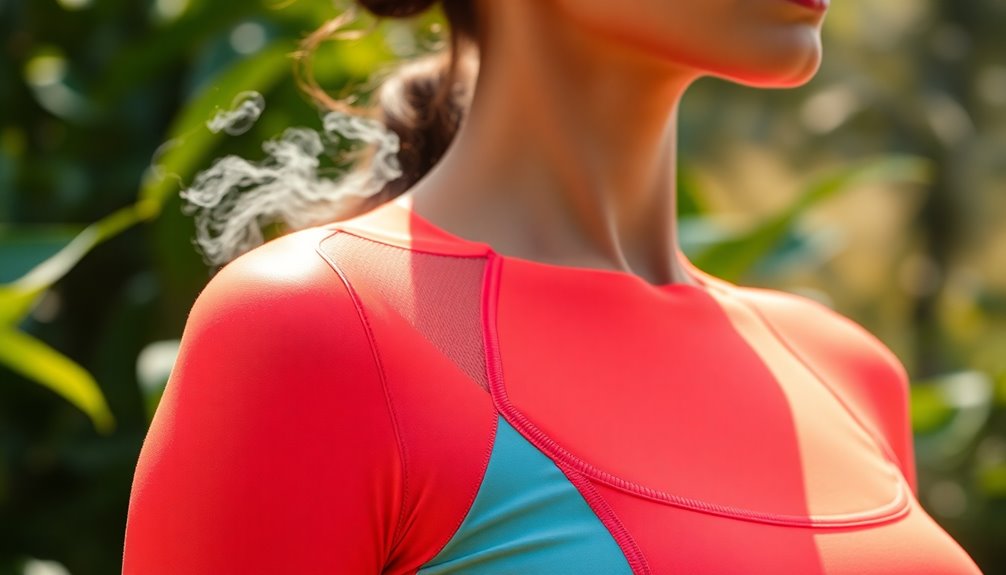Spandex isn't particularly breathable. Its tight weave and synthetic makeup limit airflow, which can lead to discomfort during wear. While it stretches well, the moisture-wicking properties can trap sweat and odors. Blending spandex with materials like cotton or polyester can enhance comfort, but pure spandex garments will likely feel warmer. If you're curious about improving breathability and other features of spandex, there's more to discover about your options and alternatives.
Key Takeaways
- Spandex is not highly breathable due to its tight weaves and synthetic composition, limiting airflow compared to natural fibers like cotton.
- Blending spandex with materials like cotton or polyester can enhance breathability and comfort in garments.
- Moisture-wicking properties in spandex help manage sweat but may retain odors, affecting overall wearability.
- Incorporating mesh panels and ventilation zones in designs can significantly improve airflow in spandex garments.
- Prolonged use of spandex may lead to temperature sensitivity and discomfort due to moisture-trapping properties.
Understanding Spandex Fabric Composition

While many people enjoy the comfort of stretchy clothing, understanding what makes spandex so unique is essential.
Spandex, primarily composed of polyurethane blended with polyester, offers remarkable stretch and recovery properties. Polyurethane gives it that incredible elasticity, while polyester enhances durability, making spandex a resilient choice for various garments. This material can stretch up to five times its original length, which is a key reason it's favored for form-fitting clothing.
The fabric consists of repeating chains of monomers, all held together by acid, emphasizing its synthetic nature. Unlike natural fibers like cotton or wool, spandex is entirely man-made, which contributes to its unique characteristics.
You'll often come across terms like Lycra or elastane, but remember, these refer to the same material. Knowing the composition helps you appreciate the versatility and performance of spandex in your favorite activewear and form-fitting clothes.
The Breathability Challenge of Spandex

Even though spandex is celebrated for its stretch and comfort, its breathability can be a challenge during intense physical activities. The fabric's construction greatly impacts this; tighter weaves limit airflow, while open or mesh-like weaves enhance it. Fiber density significantly affects how much air can circulate through the fabric.
Lightweight materials and finer yarns improve breathability, making your workout more comfortable. Moisture management plays an essential role too. Spandex's moisture-wicking properties help manage sweat, but it can retain odors, affecting your perception of breathability.
The breathability difference becomes most noticeable when you're really active, yet the stretchiness of spandex allows you to move comfortably. Comparatively, natural fibers like cotton are generally more breathable, but spandex blends offer durability and flexibility, making them a popular choice for activewear.
Exploring Spandex Blends for Enhanced Comfort

When you choose spandex blends, you're not just opting for stretch; you're enhancing your overall comfort and performance. These blends improve fabric flexibility and maintain shape, offering a snug yet comfortable fit. You can mix spandex with various fibers, tailoring your choice to different activities. For everyday wear, cotton-spandex provides breathability and softness. If you're into sports, polyester-spandex is your go-to, as it's durable and quick-drying. Spandex blends have revolutionized the textile industry, offering improved performance and flexibility. Rayon-spandex blends add a lightweight feel, perfect for dresses, while bamboo-spandex is eco-friendly and breathable for loungewear. Wool-spandex keeps you warm in winter with its moisture-wicking properties.
Health and Environmental Implications

Spandex may cause skin irritation or allergic reactions due to its synthetic materials, and its moisture-trapping properties can lead to discomfort during wear. While it offers a snug fit, prolonged use can restrict airflow, raising temperature sensitivity issues. Furthermore, spandex is often blended with other fibers to enhance comfort and fit, which can impact the overall breathability of the fabric.
Environmentally, spandex production relies on fossil fuels and harsh chemicals, contributing to pollution and ecological harm. It's non-biodegradable and releases microplastics that can contaminate water sources, posing risks to both marine life and human health.
Applications of Spandex in Everyday Wear

Spandex plays an important role in enhancing the fit and comfort of a wide range of everyday wear, making it a staple in modern fashion.
You'll find it in undergarments like bras and panties, providing the stretch and comfort you crave. Swimwear also benefits from spandex, hugging your body perfectly as you plunge in.
When it comes to sportswear, spandex offers a snug fit and support, especially in athletic leggings and sports bras. Plus, it's vital in shapewear, helping create flattering silhouettes. Stretchability of spandex allows these garments to maintain their shape even after extensive use.
In casual wear, stretch jeans, leggings, and fitted tops incorporate spandex for added elasticity and comfort.
Even socks use spandex to guarantee they stay in place, enhancing your overall experience with everyday clothing.
Strategies for Improving Breathability in Spandex Garments

To maximize comfort and performance in spandex garments, improving breathability is key. You can achieve this by opting for fabric blends that combine spandex with breathable materials like cotton or polyester. Incorporating mesh panels allows for better ventilation, while moisture-wicking technology helps transport sweat away from your skin. Look for designs featuring ventilation zones to enhance airflow and reduce moisture buildup. Consider garments with breathable linings or stretchable mesh materials for added comfort. Aerodynamic cuts can reduce wind resistance and facilitate airflow, while advanced weaving techniques improve overall breathability. Additionally, keep in mind that spandex is typically blended with other fibers rather than used in pure form, which can influence the garment's breathability. Finally, innovative treatments like hydrophilic coatings and microporous finishes can greatly enhance moisture management, keeping you cool and comfortable during wear.
Frequently Asked Questions
Can Spandex Be Used for Outdoor Sports in Hot Weather?
Absolutely, spandex is a great choice for outdoor sports in hot weather.
Its moisture-wicking properties help keep you cool and dry, especially during intense activities. When blended with breathable fabrics, spandex enhances comfort and airflow.
You'll appreciate its quick-drying capabilities, which are perfect for sweat-heavy workouts. Plus, the stretchability allows for freedom of movement, ensuring you can perform at your best without feeling restricted.
Just remember to care for it properly!
How Does Spandex Compare to Cotton in Breathability?
When you compare spandex to cotton regarding breathability, you'll notice that cotton generally wins.
It allows air to circulate, keeping you cooler during workouts.
Spandex, while great for its stretch and moisture-wicking abilities, retains heat, which can lead to discomfort.
If you're looking for comfort and breathability, cotton's your best bet.
However, if you need flexibility and support, spandex has its advantages, especially when blended with other materials.
Is Spandex Suitable for Sensitive Skin Types?
If you have sensitive skin, you might find spandex isn't the best choice.
While it's stretchy and comfortable, it can trap heat and moisture, leading to irritation. You should consider blends with breathable materials like cotton or bamboo to enhance comfort.
Look for hypoallergenic labels, and choose loose-fitting options to minimize friction.
Also, washing your spandex in mild detergents can help reduce potential skin reactions.
Always listen to your body and prioritize what feels right.
Are There Any Eco-Friendly Alternatives to Traditional Spandex?
You might think traditional spandex is the only option for stretchy comfort, but eco-friendly alternatives are making waves.
You can explore materials like Eco LYCRA T400, which uses recycled plastics, or DuPont Sorona, partially made from plant-based sources.
Econyl offers regenerated nylon, while bio-based spandex is biodegradable.
These options reduce your carbon footprint, keep you comfortable, and help the planet—who knew going green could feel so good?
Can Spandex Garments Be Recycled or Composted?
You might find it challenging to recycle or compost spandex. Its synthetic nature makes it non-biodegradable, and current composting methods aren't suitable for it.
While less than 1% of textile waste gets recycled, new methods like the DMSO solvent show promise for spandex recycling.
Unfortunately, until these technologies become widely adopted, spandex garments often end up in landfills, contributing to long-term environmental issues.
Exploring alternatives is essential for sustainability.
Conclusion
In the world of fashion, spandex often feels like a second skin, hugging your curves while restricting airflow. Yet, when blended with natural fibers, it transforms into a breathable companion that adapts to your movements. You're caught between the snug fit of spandex and the desire for comfort. By choosing the right blends and designs, you can enjoy the best of both worlds—supportive stretch and invigorating breathability, making every outfit a perfect harmony of style and comfort.









